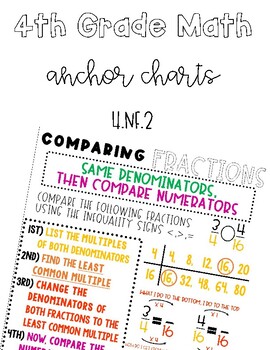Comparing Fractions with Unlike Denominators | Anchor Chart | Area Model
- PDF
What educators are saying
Also included in
- Introducing our comprehensive Fourth Grade Math Mega Bundle – your one-stop solution for mastering all the fourth-grade math standards! This bundle combines all the digital step-by-step instruction products from our collection, offering a treasure trove of resources to support your students' math lePrice $63.00Original Price $71.50Save $8.50
- This 100% EDITABLE PowerPoint Presentation is perfect for introducing multiple methods for comparing fractions. The strategies included are finding common denominators, cross multiply, number line, model, and comparing to one half. By utilizing the pen feature on PowerPoint, you are able to draw rigPrice $4.00Original Price $5.00Save $1.00
- Enhance your math instruction with our comprehensive Fraction Anchor Chart BUNDLE! This bundle includes detailed anchor charts for teaching and reinforcing essential fraction concepts such as adding, multiplying, comparing, and converting fractions. Perfect for visual learners, these anchor charts pPrice $14.50Original Price $21.00Save $6.50
Description
Help your students master comparing fractions with unlike denominators using our detailed Anchor Chart! Aligned with CCSS 4.NF.2, this anchor chart provides clear, visual instructions for understanding how to compare fractions using the least common multiple and area models. Ideal for both digital and print use, this resource is perfect for enhancing fraction lessons in your classroom.
What's Included:
- Two Anchor Charts for Comparing Fractions: Detailed steps for finding the least common multiple and comparing fractions using area models. One anchor chart uses vertical instructions while the other has horizontal instructions.
- Visual Aids: Clear illustrations to help students understand complex concepts.
- Step-by-Step Instructions: Guides for solving problems with unlike denominators.
- Digital and Printable Versions: Use in digital classrooms or print for physical displays.
Key Features:
- Aligned with Common Core Standards: Supports CCSS 4.NF.2 for comparing fractions.
- Visual Learning Aid: Enhances student understanding through clear visual representations.
- Versatile Use: Ideal for classroom displays, student reference sheets, and digital learning.
- Engaging Design: Keeps students engaged and makes learning fractions fun.
Perfect For:
- Elementary and Middle School Teachers: Simplify the teaching of comparing fractions.
- Math Intervention: Provide extra support for students who need it.
- Homeschooling: Use as a visual aid to enhance math lessons at home.
- Tutoring: A valuable resource for math tutors working with students on foundational skills.
Related Products:
- Fraction Anchor Chart BUNDLE | Adding, Multiplying, Comparing, Converting
- Decimals to Fractions Anchor Chart | Area Model | Written Word Form
- Adding Fractions with Unlike Denominators Anchor Chart
Tags: Comparing Fractions, Unlike Denominators, Anchor Chart, Area Model, Fractions, Math Strategies, Common Core Math, Visual Learning, Elementary Math, Middle School Math, Printable Math Resources, Digital Math Resources, Operations and Algebraic Thinking Standards, Factors, Multiples, Factor Pairs, Skip Counting, Count Bys, Prime and Composite, Least Common Multiple, Greatest Common Factor, 4.OA.4, Fourth Grade Math, Measurement and Data Standards, Metric Conversions, Standard Conversions, Convert Using Division, Convert Using Multiplication, Metric Ladder, Length Conversions, Capacity Conversions, Weight Conversions, Time Conversions, Distance Learning Resource, Planogram Anchor Chart.






